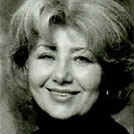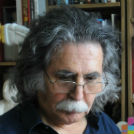| A |
|
 | Ragheb Ayad, born on 10 March 1892 in Cairo, Egypt, was a prominent painter belonging to a generation of Egyptian artists known as al-ruwwād or "pioneers." He was among the first students to join the School of Fine Arts in Cairo, from which he graduated in 1911. After receiving a scholarship to study in Rome, he was appointed head of the Decoration Department at the School of Applied Arts in Giza in 1930. In 1937, he was named director of the Free Section of the School of Fine Arts in Cairo. Between 1950 and 1955, he headed the Museum of Egyptian Modern Art. Throughout his career Ayad developed a folklorist style to depict scenes of daily rural life and popular traditions. Ayad died on 16 December 1982 in Cairo, Egypt.
Read more |
|
 | Suad al-Attar was born in Baghdad, Iraq. As one of Iraq's leading female artists, Al-Attar earned degrees from the Baghdad University and California State University. She also did graduate work in London, studying printmaking at the Wimbledon School of Art and the Central School of Art and Design. Following her studies, al-Attar taught at the University of Baghdad. In 1965, the artist was the first woman who held a solo exhibition in Baghdad. Al-Attar works in both print and paint media drawing on graphic qualities with flat and linear surfaces. Her surreal canvases have a uniquely mysterious quality that resonates with Iraq's rich literary past. Al-Attar's work is held in both private and public collections, including many prestigious art institutions like the British Museum and Mathaf: Arab Museum of Modern Art in Doha, Qatar. She currently lives and works in London.
Read more |
|
 | Yousef Ahmad, born in 1955 in Doha, Qatar, is considered one of the pioneering figures of modern and contemporary art in Qatar and the Gulf region. His lifelong passion for experimentation with a wide range of media, including oil and acrylic on canvas or panel, silkscreen paint on board, and watercolor on paper ultimately led him to create his unique paper made from locally grown Qatari palm trees. Ahmad has developed his innovative style of Huroufiyyah, calligraphy in which Arabic letters are individually manipulated to highlight the aesthetics of their abstract arrangements, Islamic culture and Arab heritage. In his large-scale artwork, Ahmad uses Arabic letters more as shapes than as signifiers. Ahmad, together with Mohammed Ali Abdulla and Hassan al-Mulla founded a group called The Three Friends in the mid-1970s, and co-founded the Friends of the Fine Art Society ten years later. Ahmad is a member of Qatar Award Jury and of Hand Papermaking International Board of Advisors. He currently serves as Senior Advisor at the Cultural Advisor Office, Qatar Foundation in Doha, Qatar.
Read more |
|
 | Dia al-Azzawi belongs to a generation of artists and intellectuals who were galvanized in their youth by the politics of Arab nationalism but crushed by the violence of dictatorship brought about by politics. His practice developed in response to that violence, becoming in the 1970s a witness to the various forms of oppression that broke out across the Arab world. In the aftermath of the American invasion of Iraq in 2003 and the violence it unleashed, al-Azzawi has renewed his practice of bearing witness in art. Since the sixties, his art has consistently been characterized by a particular way of working between text and image, one that generated a signature mode of figuration and gave rise to a particular art form, the art book, which he would come to call the daftar/dafatir or notebook. He has at different times worked in oil, acrylic, sculpture, and various techniques of printmaking. Over the years, al-Azzawi has also published a number of articles in magazines, newspapers and journals, and has curated several regional and international exhibitions.
Read more |
